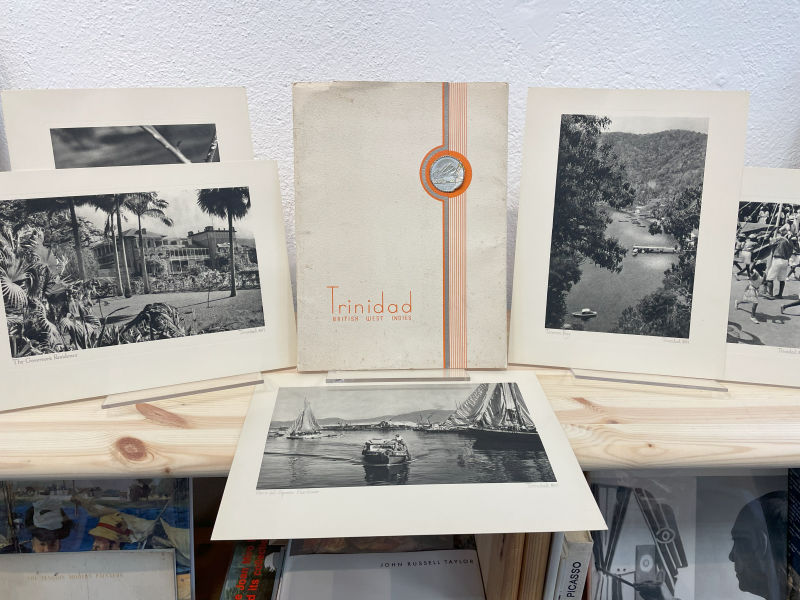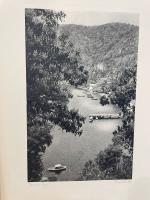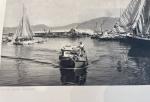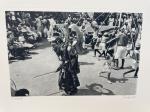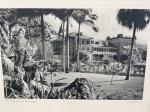Minshall, The Trinidad Portfolio - Sixteen Pictures (Original Photographs / Phot
The Trinidad Portfolio – Sixteen Pictures (Original Photographs / Photogravures on heavy paper, showing Trinidad Carnival, Trinidad Nature, Port-of-Spain-Harbour, The Queen’s Park Hotel, People of Trinidad (East Indian Silversmith), Teteron Bay, Santa Cruz Valley, Macqueripe Bay, Mardi Gras Carnival etc.) – The sixteen Photographs are all placed in the original Folder, titled: “Trinidad – British West Indies” and with the blindstamped aluminium-seal “″Miscerique probat populos et fœdera jungi” [which translated as “He approves of the mingling of peoples and their being joined together by treaties”].
Trinidad, The Tourist and Exhibitions Board of Trinidad and Tobago [Printed in England], no year (c.1945-1950). 23 cm wide x 31 cm high. 16 original photogravures inside the original Folder, issued by the Tourist and Exhibitions Board of Trinidad and Tobago. The 16 Photographs measure: 22.7 cm x 30.3 cm (some are oblong-formats some in portrait-format). Softcover / Original Folder. Very good condition with only minor signs of external wear. The aluminium – seal slightly bent. Interior and photographs in absolutely excellent condition. Extremely scarce !
This sensational Portfolio was published in the final years of British Colonialism on Trinidad and the captions verso the photographs are interesting reminders of “British Possessions” (find this wording on Image No.8)
Photographs included (and with the captions, printed verso the photographs) are:
1. “Port-of-Spain Harbour” (Photograph by W. Minshall) – This is No.1 in “The Trinidad Portfolio” of sixteen pictures.
″Before the construction of the deep-water quay, ocean-going steamers anchored three or four miles from Port-of-Spain, in the Gulf of Paria, and were serviced by launches for passengers and lighters for cargo. The new harbour, started in 1935 and completed in 1939 at a cost of nearly $5.000,000 provides a quay 3,300 feet long with 30 feet of water at dead low tide.
2. “Ruby Topaz – Humming Bird” (Photograph by R.E.Johnson) – This is No.2 in the “Trinidad Portfolio” of sixteen pictures
″Trinidad was called lere- “Land of Humming Bird” by its aboriginal Indian inhabitants long before white men knew of its existence. To-day there are seventeen species of humming bird on record, present everywhere although no longer seen by thousands as recorded barely a century ago. Certain species have their favourite habitats, the “Ruby Topaz” being found most frequently at the fringe of the forests.″
3. “The Queen’s Park Hotel” (Photograph by W.Minshall) – This is No.3 in “The Trinidad Portfolio” of sixteen pictures
″It is difficult to write about a city that is in a period of transition. Tod-day’s relities may be to-morrow’s memories. Hotels, restaurants, shops – everything changes. Queen’s PArk Hotel, a rambling wooden structure now – the most famous hotel in the West Indies – may be a skyscraper before you read this” [Eleanor Early in “Ports of the Sun” (1937)].
4. “The Governor’s Residence” (Photograph by W.Minshall) – This is No.4 in “The Trinidad Portfolio” of sixteen pictures
″Officially called Government House – the familiar “G.H.” of all British colonies – the Governor’s residence in Port-of-Spain is situated in spacious grounds adjacent to the Royal Botanic Gardens. It was built in 1874-75”.
5. “East Indian Silversmith” (Photograph by W.Minshall) – This is No.5 in “The Trinidad Portfolio” of sixteen pictures
″Trinidad has 94.000 Hindus and 20,000 Mohammedans, who, with a smaller number of Indians following other religions, form one-third of the island’s population. The East Indian community – established by procuring agricultural labourers as indentured immigrants from 1845 to 1916 – is now represented in trade and the professions but preserves much of its fascinating oriental background”.
6. “Teteron Bay” (Photograph by W.Minshall) – This is No.6 in “The Trinidad Portfolio” of sixteen pictures
″The 14-mile drive from Port-of-Spain to Teteron Bay reveals some of the loveliest coastal scenery in Trinidad. Westward from Teteron, a fishing village, lie the Bocas del Dragon, or “Dragon’s Mouth” through which ocean-going vessels enter the Gulf of Paria”.
7. “Saman Tree at Country Club” (Photograph by W.Minshall) – This is No.7 in “The Trinidad Portfolio” of sixteen pictures
″Of all the trees in Trinidad, the Saman, with its umbrella-like spread, is probably the most conspicuous. It is not indigenous but has been extensively planted for shade purposes. The Saman originally introduced into the colony stands in the Royal Botanic Gardens, near Government House”.
8. “Carnival” (Photograph of Mardi Gras in Trinidad by W.Minshall) – This is No.8 in “The Trinidad Portfolio” of sixteen pictures
″Trinidad is one of the few British possessions in which Mardi Gras Carnival celebrations precede the Lenten fast. Masked bands of merry-makers throng the streets of Port-of-Spain for the two-day Carnival, which is held annually on the Monday and Tuesday preceding Ash Wednesday”.
9. “On the Brasso Road” (Photograph by W.Minshall) – This is No.9 in “The Trinidad Portfolio” of sixteen pictures
″Away from the plantations of sugar cane, coconuts and citrus-fruits, Trinidad’s countryside is a riot of luxuriant foliage. The Brasso Road leads to extensive coca estates on the Central Range”.
10. “Immortelles in Blossom” (Photograph by W.Minshall) – This is No.10 in “The Trinidad Portfolio” of sixteen pictures
″During January and February many valleys and hillsides are aflame with the red-orange blossom of the Immortelles. On practically all cocoa estates these trees were planted to give shade to the cocoa”.
11. “Bird and Beauty” (Photograph by W.Minshall) – This is No.11 in “The Trinidad Portfolio” of sixteen pictures
″The pert macaw faces the camera with less composure than its owner, an East Indian, who takes care of birds and animals in a small private zoo near Port-of-Spain″
12. “Queen’s Park Savannah” (Photograph by W.Minshall) – This is No.12 in “The Trinidad Portfolio” of sixteen pictures
″In the early years of the 19th century Port-of-Spain’s famous public playground, covering 199 acres, was acquired from estate owners by the illustrious Cabildo, the municipal authority of the day and transferred to the Government in 1825. The Savannah now provides accommodation for the splendid race track of the Trinidad Turf Club and is used all the year round for football, cricket and other sports”.
13. “Two-Ox Power” (Photograph by Louis Tucker) – This is No.13 in “The Trinidad Portfolio” of sixteen pictures
″Oxen and water buffalo are still used as draught animals in many parts of Trinidad, sharing the roads with haulage trucks plying to the oilfields, crowded buses and the newest models from famous automobile factories”.
14. “The Santa Cruz Valley” (Photograph by W.Minshall) – This is No.14 in “The Trinidad Portfolio” of sixteen pictures
″Practically every visitor in TRinidad drives over “The Saddle” (so called from the shape of the hills) and marvels at this vista of grapefruit orchards in the Santa Cruz Valley”.
15. “Sunrise from Monos” (Photograph by W.Minshall) – This is No.15 in “The Trinidad Portfolio” of sixteen pictures
″Monos is the Island nearest to Trinidad in the Bocas del Dragon or “Dragon’s Mouth”, the gateway to the Gulf of Paria and Port-of-Spain harbour. Monos and other islands in the Gulf are favourite local holiday resorts”.
16. “Macqueripe Bay” (Photograph by W.Minshall) – This is No.16 in “The Trinidad Portfolio” of sixteen pictures
″Macqueripe Bay, Trinidad’s most popular beach resort, is a sheltered cove on the North Coast, 10 miles from Port-of-Spain. A modern hotel, commanding a magnificent view towards the distant mountains of Venezuela, is a new and attractive development at Macqueripe”.
- Keywords: Caribbean · Catalogue Six – Photography · Karibik · Mardi Gras Photograph (Vintage) · Photography · Photography – Rare · Travel & Expedition – Rare · Travel The Americas – Rare · Trinidad · Vintage Photograph 20th century · Vintage Photographs · Vintage Photographs 20th century · West Indies
- Language: English
- Inventory Number: 31557AB
EUR 3.800,--
© 2025 Inanna Rare Books Ltd. | Powered by HESCOM-Software




